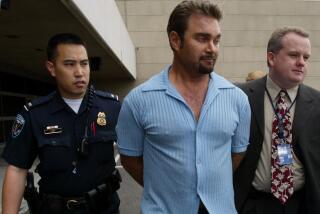Subject of Parole Furor Gets Life : Justice: An attacker who sparked reforms in 1975 with a repeat offense just nine days after he left prison was sentenced for killing and raping a girl.
A Glendale man who provoked a major public outcry against California’s parole policies by assaulting a Burbank woman just nine days after his release from prison in 1975 was sentenced to life in prison without possibility of parole for the 1988 rape and murder of a Pacoima teen-ager.
Charles Kenneth Anderson, 46, who has a 23-year history of attacking women in the San Fernando Valley, was convicted in March by a Los Angeles Superior Court jury of raping and killing Suzanne Thomas, 16, and sentenced Thursday.
Because Anderson was convicted of a murder committed in the course of another felony--in this case, sexual assault--he will not be eligible for parole, said Deputy Dist. Atty. Ralph W. Plummer.
The sentence is ironic, Plummer said, because in the mid-1970s Anderson’s case added fuel to the controversy over California sentencing rules and parole policies then in effect, which were later altered to give judges more power in sentencing criminals.
Just nine days after his 1975 release from eight years in prison for a string of sexual assaults on Valley women, Anderson attacked and permanently disfigured a young woman shortly after she arrived for work at a Burbank real estate office.
The woman, the wife of a Los Angeles police officer, was beaten, stabbed and choked, until she was rescued by a passing officer who heard her screams, Plummer said.
The case became a cause celebre for law enforcement officials who wanted to reform California’s sentencing system, Plummer said.
Before 1977, the California Penal Code established minimum and maximum sentences for specific crimes, but gave the state Parole Board almost total control of the length of a convict’s incarceration.
Supporters of so-called “indeterminate sentences” said they allowed the state to hold criminals for long periods if they were identified as particularly dangerous. But some law enforcement officials complained that the policy enabled the state to release prisoners after very short periods in custody.
Anderson first went to prison in 1967 for sexual assaults on women whom he kidnaped from five Valley bars. “He would go in and rob these beer bars, kidnap the barmaids, and force them to orally copulate him,” Plummer said.
Anderson’s subsequent attack while out on parole incensed law enforcement officials, who argued that he should not have been released.
“People said ‘Why in the world did you let this guy out?’ and it sparked a real lot of controversy, an attack on the parole system,” Plummer said. “People said it was a travesty of justice.”
In 1977, the California Legislature adopted a policy that requires judges to determine fixed sentences from a narrow range of alternatives given for each crime.
The new policy was founded on the assumption that rehabilitation of criminals was not effective and prison time should be viewed primarily as punishment, which should be uniform throughout the state.
Plummer said that in the aftermath of the Anderson case and several similar cases, citizens supported more power for judges because the judges are accountable to the voters and would therefore impose stricter sentences.
Anderson pleaded guilty to mayhem with intent to commit great harm, and returned to state prison. He served six years, until his parole in 1982.
“We lost track of him until 1988,” Plummer said.
More to Read
Sign up for Essential California
The most important California stories and recommendations in your inbox every morning.
You may occasionally receive promotional content from the Los Angeles Times.









